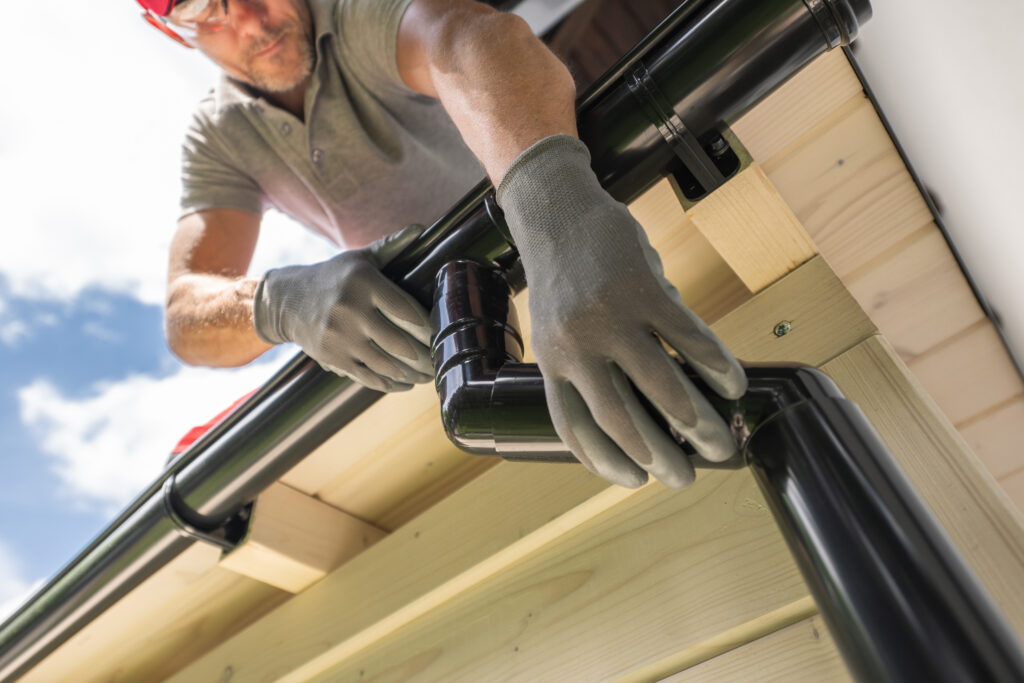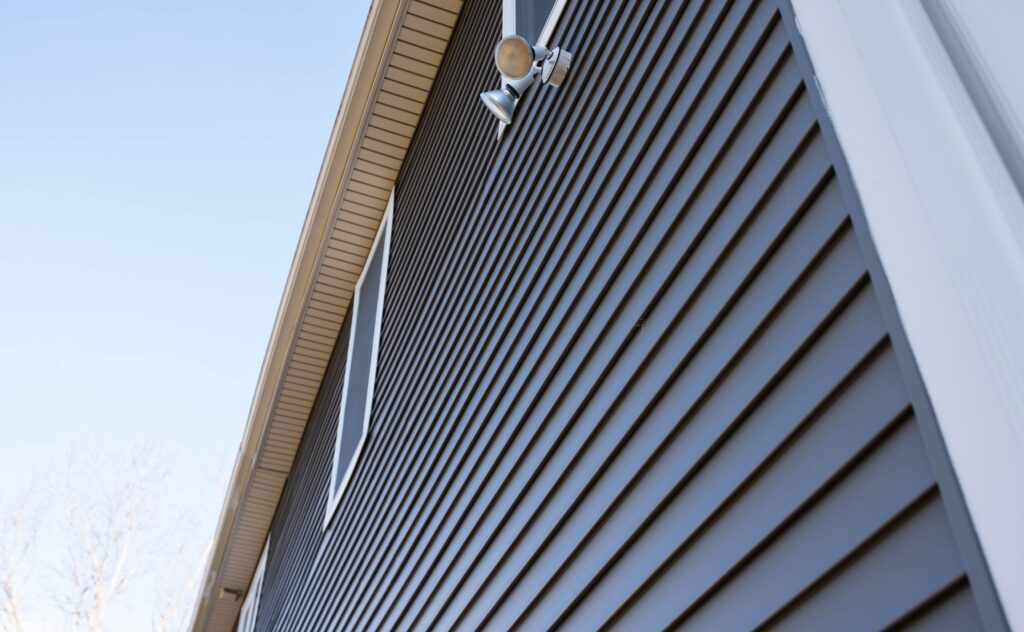1. Missing or Damaged Shingles
What to Look For:
After a storm, check for missing, cracked, or curled shingles. High winds can easily blow shingles off your roof, while hail can crack or bruise them. Damaged shingles compromise your roof's ability to protect your home from leaks and water damage.
What It Means:
Missing or damaged shingles create vulnerable spots on your roof, allowing rainwater to seep in and cause structural damage. This can lead to mold, mildew, or wood rot if not repaired quickly.
2. Water Stains on Your Ceiling
What to Look For:
One of the most common signs of roof damage is water stains or discoloration on your ceiling or walls. If you've noticed any wet spots, peeling paint, or mold growth, it may be a sign that water has infiltrated your roof.
What It Means:
Water stains indicate that your roof is leaking. A leak can be caused by missing shingles, damaged flashing, or cracks that allow rainwater to seep through. If not addressed, this can lead to major water damage inside your home.
3. Cracked or Damaged Flashing
What to Look For:
Flashing is the metal or plastic material installed around chimneys, vents, and skylights to prevent water from seeping in. After a storm, inspect the flashing to ensure it hasn’t been bent, cracked, or detached. If you notice any signs of damage, it’s important to repair it immediately.
What It Means:
Damaged flashing can create gaps where water can enter, leading to leaks and further roof damage. If your flashing is compromised, it’s crucial to replace or repair it to prevent more extensive damage.
4. Fallen Debris
What to Look For:
After a storm, check your roof and yard for fallen tree branches, leaves, or debris. Large branches or fallen trees can create punctures in your roof, which can cause leaks or even a collapse in extreme cases.
What It Means:
Fallen debris can damage shingles, cause punctures, or even create large gaps in your roof. Depending on the severity, this can leave your home vulnerable to further water damage.
5. Sagging Roof Deck
What to Look For:
Inspect your roof’s structural integrity from the attic or interior of your home. If you notice sagging or warped areas in the roof deck, it may be a sign of serious structural damage caused by heavy snow, rain, or high winds.
What It Means:
A sagging roof deck could indicate significant water damage, rotting wood, or even potential structural collapse. This is a serious concern and requires immediate professional attention.
6. Hail Damage
What to Look For:
After a hailstorm, look for small, round dents or dimples on your shingles, especially if the hailstones were large. Hail damage can create cracks or weaken the shingles’ ability to shed water, leading to leaks.
What It Means:
Hail damage may not be immediately visible from the ground, but upon closer inspection, it can weaken shingles and lead to future leaks or water damage. If you suspect hail damage, it’s best to call a professional roofer to assess the situation.


Why Gutter Maintenance is Crucial for Your Home
Water Damage Prevention:
Clogged gutters prevent water from flowing freely off the roof and away from your home. This can cause water to overflow, resulting in damage to your roof, walls, and foundation. Over time, this can lead to expensive repairs and structural damage.
Protect Your Landscape:
Overflowing gutters can also damage your landscaping, causing soil erosion and flooding in your garden or yard. By maintaining clean gutters, you’re helping to protect your property’s landscaping.
Prevent Mold and Mildew:
When water backs up due to clogged gutters, it can seep into your home, leading to mold and mildew growth. These issues can affect your home’s air quality and lead to health concerns for your family.
Foundation Protection:
If water isn’t directed away from your home properly, it can seep into the foundation. Over time, this can lead to cracks and settling, which are costly to repair. Well-maintained gutters help protect your foundation from water damage.
How to Prevent Gutter Clogs
1. Regular Cleaning and Inspection
Frequency:
Clean your gutters at least twice a year – once in the spring and once in the fall, or more frequently if you have overhanging trees near your home.
What to Look For:
When cleaning your gutters, be sure to remove any leaves, twigs, and other debris. Also, check for any signs of wear and tear, such as holes, rust, or cracks that could cause leaks. It’s also important to inspect the downspouts to make sure they aren’t clogged, as water can’t flow properly if the downspouts are blocked.
2. Install Gutter Guards
What They Do:
Gutter guards are protective covers that fit over your gutters and allow water to flow through while keeping debris out. They can reduce the frequency of gutter cleaning and prevent leaves and twigs from collecting inside your gutters.
Types of Gutter Guards:
There are several types of gutter guards to choose from, including mesh, screen, and foam guards. While mesh and screen guards filter out larger debris, foam guards help prevent smaller particles from clogging your gutters.
Why They're Beneficial:
Gutter guards save you time and effort by reducing the need for frequent cleaning. They also protect your gutters from damage and help ensure that rainwater flows smoothly, minimizing the risk of overflow.
3. Trim Overhanging Branches
Why It’s Important:
Trees with branches hanging over your roof and gutters are a major source of debris. Leaves, twigs, and even small branches can accumulate in your gutters, causing clogs.
What to Do:
Trim any branches that are close to your roof to prevent debris from falling into your gutters. This not only helps with gutter maintenance but also reduces the risk of tree damage during storms.
4. Consider Gutter Downspout Extensions
What They Do:
Downspouts direct water away from your roof, but if they are too short, water can spill over and cause flooding around your foundation. Installing downspout extensions can help direct the water further from your home, preventing water damage to your foundation.
Why They’re Helpful:
Downspout extensions are especially useful in areas with heavy rainfall. They can help prevent water from pooling around your foundation and help with drainage during storms.
5. Ensure Proper Gutter Slope
What It Is:
Gutters should be sloped slightly toward the downspouts to ensure proper water flow. If your gutters are not sloped correctly, water may pool in certain areas, encouraging debris to build up.
What to Do:
When cleaning your gutters, check the slope to ensure water flows toward the downspouts. If you notice that the slope is uneven, call a professional to have your gutters re-sloped to maintain optimal performance.
6. Invest in Professional Gutter Maintenance
Why It’s Worth It:
While cleaning your gutters is essential, sometimes it’s worth investing in professional gutter maintenance. A roofing expert can ensure your gutters are working properly, install gutter guards, and handle any repairs or upgrades your system might need.
Types of Siding Materials
1. Vinyl Siding
What It Is:
Vinyl siding is one of the most popular and affordable siding options. It is made from polyvinyl chloride (PVC) and comes in a variety of styles, including horizontal and vertical panels, shingles, and shakes.
Benefits:
Low Maintenance: Vinyl siding doesn’t need to be painted or stained, and it resists fading.
Durability: It’s resistant to rot, pests, and harsh weather conditions.
Energy Efficiency: Vinyl siding can be insulated, offering additional protection against the elements.
Considerations:
Limited Design Choices: While it comes in many colors and textures, vinyl doesn’t offer as much variety as some other materials.
Potential for Cracking: In extreme temperatures, vinyl siding can crack or become brittle.
2. Wood Siding
What It Is:
Wood siding has been used for centuries and is a classic, natural option for many homes. It can be installed in planks, shingles, or shakes, and is available in various types of wood like cedar, pine, or redwood.
Benefits:
Aesthetic Appeal: Wood siding provides a beautiful, timeless look that complements a variety of architectural styles.
Insulation: Wood has natural insulating properties, helping to regulate indoor temperatures.
Eco-Friendly: If sourced sustainably, wood siding is an environmentally friendly option.
Considerations:
Maintenance Requirements: Wood siding needs regular painting or staining to protect it from moisture, pests, and rot.
Vulnerable to Rot: Without proper maintenance, wood siding can rot and become infested with insects.
3. Fiber Cement Siding
What It Is:
Fiber cement siding is made from a mixture of cement, sand, and cellulose fibers. It can mimic the look of wood, stucco, or masonry and comes in planks, panels, or shingles.
Benefits:
Durability: Fiber cement is resistant to rot, pests, and fire, making it an extremely durable choice.
Low Maintenance: It requires minimal maintenance compared to wood, and it’s available in pre-painted finishes.
Aesthetic Variety: It can mimic the look of more expensive materials, such as stone or wood, without the added cost.
Considerations:
Heavy Material: Fiber cement is heavier than other materials, which may increase installation costs.
Cost: It’s more expensive than vinyl but offers a longer lifespan and greater durability.
4. Aluminum Siding
What It Is:
Aluminum siding is a metal option that is lightweight, durable, and available in a variety of colors and finishes.
Benefits:
Durability: It’s resistant to fire, rot, and insects.
Low Maintenance: Aluminum siding doesn’t need to be painted as often as wood and won’t warp or rot like vinyl.
Eco-Friendly: Aluminum is a recyclable material, making it an environmentally conscious choice.
Considerations:
Prone to Dents: Aluminum can dent more easily than other materials if struck by hail or debris.
Fading: Over time, aluminum may fade due to sun exposure.
5. Brick and Stone Siding
What It Is:
Brick and stone are classic, durable siding materials that add a sense of permanence and elegance to a home. These materials are often used in combination with other siding types for accent areas.
Benefits:
Longevity: Brick and stone can last for decades, with very little maintenance required.
Aesthetic Appeal: Both materials offer a luxurious, timeless look.
Energy Efficiency: They are naturally insulating and can help with temperature control in the home.
Considerations:
Cost: Brick and stone are some of the most expensive siding materials available.
Installation: Due to their weight and complexity, brick and stone installation can be costly and time-consuming.
6. Stucco Siding
What It Is:
Stucco is a plaster-like material that is often applied over a wire or concrete base. It’s popular in Mediterranean, Spanish, and Southwestern-style homes.
Benefits:
Energy Efficiency: Stucco provides excellent insulation, helping to regulate indoor temperatures.
Durability: Stucco is fire-resistant, weather-resistant, and can last for decades with proper care.
Aesthetic Flexibility: Stucco can be textured and painted in a wide range of finishes.
Considerations:
Cracking: Stucco can crack over time, especially in areas with extreme weather fluctuations.
High Maintenance: Proper care and occasional touch-ups are required to keep stucco in good condition.


© 2024 Copyright All rights reserved by roofsolutionllc.